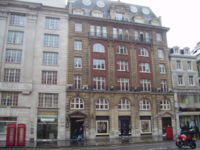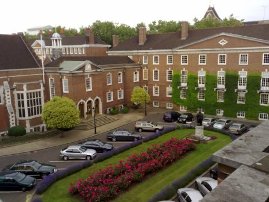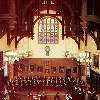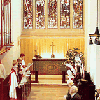 |
[ Outlaw Genealogy | Bruce
History | Lost Chords ] [ Projects | News | FAQ | Suggestions | Search | HotLinks | Resources | Ufo ] |
 |
[ Outlaw Genealogy | Bruce
History | Lost Chords ] [ Projects | News | FAQ | Suggestions | Search | HotLinks | Resources | Ufo ] |
1610 - Ralph Outlaw, of Witchingham, Norfolk, gent., and of Barnard's Inn. - Feb. 13 - Admissions Gray's Inn - "gentleman of blood" place their children in these Inns of Court (The hero of Charles Dickens's novel Great Expectations, Pip, lodged in Barnard's Inn with Herbert Pocket for a number of years following his arrival in London. (Barnard's = Undergraduate school, Grey's Inn = Graduate Law school ) )
Gray's Inn Admission Register, 1520-1889 (and Chapel Register), 700 pages, with index to 16,000 names. Only 160 copies printed. Price 3 guineas.
PREFACE.
AMONG those records of national interest which remain unpublished and
comparatively unknown, the Registers of our Inns of Court hold a
pre-eminent position. As early as the days of Henry VI , we are reminded by Sir
John Fortescue that knights, barons, and the greatest nobility of the Kingdom
often place their children in these Inns of Court, not so much to make the laws
their study, much less to live by their profession, having large patrimonies of
their own, but to form their manners.
In the Registers of these Inns we consequently find information which elsewhere we seek in vain, relating to families and individuals in every portion of the realm ; the fact, moreover, that this information is contained in a legal register, invests it with an authority superior to that of the treasured Heralds' Visitations, while it enjoys with them the advantage of dealing with the aristocratic classes. For, to quote from Feme's Glory of Generosity (London, 1586): — "Nobleness of blood, joyned with virtue, compteth the person as " most meet to the enterprizing of any public service ; and for that cause it was, not " for nought, that our ancient Governors in this land, did with a special foresight and "Wisdom, provide, that none should be admitted into the Houses of Court, being Seminaries, sending forth men apt to the Government of Justice, except he were a gentleman of blood."
This being so, it may appear surprising that records covering so extensive a period and of such unrivalled interest, should have remained virtually inaccessible, and consequently little consulted, since Sir William Dugdale drew so largely upon them for the compilation of " Origines Juridiciales," more than two centuries ago. But in this instance, as in some others, the explanation is doubtless to be found in the magnitude of such an undertaking as their transcription and publication.
 Barnard's
Inn dates back at least to the mid 13th century — it was recorded as part
of the estate of Sir Adam
de Basyng, one time Mayor of London. It passed on to John
Mackworth, the Dean
of Lincoln
who in turn passed it on to the Dean
and Chapter of Lincoln on his death in 1451. Three years later, it was
established as an Inn
of Chancery — these were schools for law students before they passed on to
an Inn
of Court. Barnard's Inn was one of two Inns of Chancery linked to Gray's
Inn, the other being Staple
Inn.
Barnard's
Inn dates back at least to the mid 13th century — it was recorded as part
of the estate of Sir Adam
de Basyng, one time Mayor of London. It passed on to John
Mackworth, the Dean
of Lincoln
who in turn passed it on to the Dean
and Chapter of Lincoln on his death in 1451. Three years later, it was
established as an Inn
of Chancery — these were schools for law students before they passed on to
an Inn
of Court. Barnard's Inn was one of two Inns of Chancery linked to Gray's
Inn, the other being Staple
Inn.
Barnard's Inn was badly damaged during the Gordon Riots in 1780. An adjacent distillery, owned by a Roman Catholic, Mr Langdale (who escaped), was set alight by rioters. The Hall and other buildings were damaged and one of the officers of the Inn witnessed a "sturdy fellow" pumping up gin from the cellar which he proceeded to sell at a penny a mug to the thirsty onlookers of the fire. The Inn received £3,200 in compensation for the damage.
By the 17th century, qualified attorneys were allowed to practice from Inns of Chancery as well as Inns of Court. By 1830, it had effectively become a set of residential chambers. In 1888, the link to the Dean and Chapter of Lincoln was broken and soon it was purchased by the Mercers' Company, serving as premises for the Mercers' School until 1959. It has been used as a venue for lectures by Gresham College since 1991.
Barnard’s Inn, the first London home of Pip in Dickens’s ”Great Expectations.” The hall was superbly restored in the 1930’s, and its picturesque features include a stunning row of 500-year-old leaded glass windows and a weathered shingle roof topped by the original octagonal lantern. This tiny jewel-like building is a unique, thoroughly unspoiled vestige of medieval London, the sense of time travel it conveys enhanced by its singularly isolated location.
 Opposite is Gray’s
Inn Hall, a charming 16th-century brick building with stone trim, in which Shakespeare’s
”Comedy of Errors” had its premiere in 1594. It is widely believed that
the hall’s ornate screen was made from the wood of a Spanish galleon captured
during the Armada’s ill-fated assault on England in 1588, and given to
Gray’s Inn by Queen Elizabeth I.
Opposite is Gray’s
Inn Hall, a charming 16th-century brick building with stone trim, in which Shakespeare’s
”Comedy of Errors” had its premiere in 1594. It is widely believed that
the hall’s ornate screen was made from the wood of a Spanish galleon captured
during the Armada’s ill-fated assault on England in 1588, and given to
Gray’s Inn by Queen Elizabeth I.
The four Inns of Court have the exclusive right to Call men and women to the Bar - ie to admit those who have fulfilled the necessary qualifications to the degree of Barrister-at-Law, which entitles them, after a period of pupillage (vocational training) either to practise as independent advocates in the Courts of England and Wales or to take employment in government or local government service, industry, commerce or finance.
In the fifteenth century there were many more legal societies or Inns than
the four Inns of Court that we know today. Those with the most active
educational programmes attracted the brighter and more ambitious students, who
in their turn became Readers and Serjeants. During this century there were more
men called to be Serjeants from Gray's Inn than any other Inn of Court.
During the sixteenth century the four Inns of Court had greatly prospered. Not
only were the Judges closely connected with the Inns, but the prosperity of the
Inns had attracted the support of the statesmen of the day. Edmund Dudley, a
financial agent and adviser to Henry VII was a fellow of Gray's Inn, until
beheaded on the orders of Henry VIII in the first year of his reign. Thomas
Cromwell, Henry VIII's persecutor of the old religious order, was a member. He
suffered the same fate for his excessive zeal later in the King's reign.
As the sixteenth century advanced, prosperity attracted a broader culture to the Inns. Good manners, courtly behaviour, singing and dancing came to the fore. Hall was cleared for the galliard and colourful masques and revels were performed. The entertainment on occasions spread to street processions and river pageants. Perhaps the Inns were too successful in these pursuits, because they soon became fashionable places for noblemen and country gentlemen to send their sons. "Of Gray's Inn" and "student of Gray's Inn" merited inclusion in epitaphs on many tombstones. Many members had no intention of becoming barristers.
Between 1561 and 1600 the average admittance to the Inn was 62, whereas the annual calls to the Bar were only 6. Nevertheless this has been named "the Golden Age" when Queen Elizabeth herself was the Inn's Patron Lady; Lord Burleigh, the Queen's First Minister, Lord Howard of Effingham, the Admiral who defeated the Spanish Armada in 1588, and Sir Francis Walsingham, the Chief Secretary who founded the Queen's secret service, were all members of Gray's Inn. It was not only from the Benchers' table that the Inn took its fame.The Inn was renowned for its "Shows" and there can be little doubt that William Shakespeare played in Gray's Inn Hall, where his patron, Lord Southampton was a member.
Between 1680 and 1687 there were three disastrous fires in Gray's Inn. That of 1684 was particularly grievous for it burnt the Library, which was then on the present site of No 1 Gray's Inn Square, and that is probably when our ancient records were lost.The fire on 21st January 1687 burnt up "5 staircases". For the next hundred years or more, qualification for call to the Bar depended on eating dinners and on the recommendation of a Judge or a Bencher. By the 1840s the regulations had changed little from the 1740s except that taking the Sacrament according to the rites of the Church of England had ceased to be a condition of Call.
The Hall
 The life of Gray's Inn
is focused on the Hall, and so it has been throughout our long history; more so
perhaps in the 15th and 16th centuries when the students resided in the Inn and
attendance at Dinner (lunch) and Supper in Hall was compulsory, as also were the
sessions of teaching and practical exercises.
The life of Gray's Inn
is focused on the Hall, and so it has been throughout our long history; more so
perhaps in the 15th and 16th centuries when the students resided in the Inn and
attendance at Dinner (lunch) and Supper in Hall was compulsory, as also were the
sessions of teaching and practical exercises.
The Hall has been its present size and shape since it was "re-edified" in 1556-8, except that it then had no screen. Even the grievous war damage of 1941 did not wholly destroy those 16th century walls, and the glass, pictures and Treasurers' shields which had been removed to a place of safety, were able to be replaced on the reconstructed walls.
The Chapel
 There is no doubt that our present Chapel is on the same site
(except for the chancel) as the Chapel provided for John le Grey in 1315. In
1539 Pension ordered that in consideration of the wishes of the King (Henry
VIII) the image of Thomas a' Becket should be removed from one of the windows.
Our records show that in 1570 there were chambers over the Chapel, for in that
year the tenants were ordered to quit. Rebuilding took place in 1689, without
any chambers. In 1893 the building was restored and remained until it was
destroyed by enemy action in 1941. From 1941 to 1960 a room in the Common
Room building was used for Divine Service. When rebuilding took place the Chapel
was enlarged and the original stained glass windows, which had been removed for
safety, were replaced. The east window, originally erected in 1895, commemorates
four archbishops who were either members or preachers of Gray's Inn: they are
Whitgift, Juxon, Wake and Laud, and the centre panel depicts Thomas a' Becket.
There is no doubt that our present Chapel is on the same site
(except for the chancel) as the Chapel provided for John le Grey in 1315. In
1539 Pension ordered that in consideration of the wishes of the King (Henry
VIII) the image of Thomas a' Becket should be removed from one of the windows.
Our records show that in 1570 there were chambers over the Chapel, for in that
year the tenants were ordered to quit. Rebuilding took place in 1689, without
any chambers. In 1893 the building was restored and remained until it was
destroyed by enemy action in 1941. From 1941 to 1960 a room in the Common
Room building was used for Divine Service. When rebuilding took place the Chapel
was enlarged and the original stained glass windows, which had been removed for
safety, were replaced. The east window, originally erected in 1895, commemorates
four archbishops who were either members or preachers of Gray's Inn: they are
Whitgift, Juxon, Wake and Laud, and the centre panel depicts Thomas a' Becket.
The
Grays Inn Theater and picture
The History and Background of Gray's Inn
Many religious groups, including the Knights Templars, were situated to the West
of the London City Walls. The Knights Templars moved from their original
premises in Holborn and bought a considerable amount of land on which they
constructed their Round Church and other buildings. This land is where Gray's
Inn is now situated.
In 1312 the order of the Knights Templars was suppressed but their place
was taken by the knights of the "Order of the Hospital of St. John of
Jerusalem". These Knights devoted themselves to caring for pilgrims and set
up a hospital which gave rise to their common name the "Hospitallers".
The Hospitallers leased many of their buildings to London lawyers which were
used as hostels, or Inns, by Barristers and Law Students and as time passed so
began the Inns of Court and Chancery (a chancellor's court, or office or
building, in which it is located). This group of buildings evolved into the
equivalent of a University which taught the Arts, Theology and Medicine as well
as the Law.
Gray's Inn - Famous for Law
Much of this history has been forgotten and Gray's Inn is now famous as one of
the four Inns of Court School of Law. English Barristers are still required to
join one of the four Inns (Gray's Inn, Middle Temple Inn, Lower Temple Inn and
Lincoln's Inn) to qualify as a barrister. Gray's Inn dates back to from 1556
(though much restored in 1951), Middle Temple from 1573 and the Old Hall, at
Lincoln's Inn, dates back to 1490.
Entertainment at Gray's Inn
Grays Inn is not generally known as a theatre. But the history and evolution of
the site explains the connection. The Great Hall at Grays Inn was often used
for lavish revels. Students who resided in Grays Inn were required to attend
compulsory suppers in the Great Hall. As the residents could not go out to
seek their entertainment the suppers were developed to produce their own
in-house entertainment. The suppers were renown for being boisterous affairs, in
fact revels, and plays were introduced to accompany the meals. The famous
courtiers and statesmen of Shakespeare's era were members of Gray's Inn and it
became a fashionable place for wealthy noblemen to send their sons (many of
which had little inclination for the Law or other Education). The courtiers
and Statesmen included Lord Burleigh, Lord Howard of Effingham, Sir Walter
Raleigh, Sir Francis Walshingham, Francis Bacon and Henry Wriothesley the third
Earl of Southampton. Gray's Inn became famous for hosting various forms of
entertainment including dancing, masques, river pageants, revels and of course
the staging of plays. Queen Elizabeth herself was the Grays Inn's Patron Lady -
it was clearly the 'In' place to be!
Shakespeare and Gray's Inn
Henry Wriothesley was the patron of William Shakespeare and his patronage bore a
strong influence on the success of Shakespeare. In 1594 Shakespeare's Comedy
of Errors was played in Gray's Inn Hall. The chronicles of the Inn comment
that: 'A company of base and common fellows.. ' gave their performance on
December 28 as part of the Christmas revels. The playwright was very probably
one of the cast.
The Gray's Inn Theatre - Shakespeare's London History Lives On...
The history of the theatres that were prominent during the life of Shakespeare
is fascinating and we have provided the London Map detailing the theatres that
Shakespeare would have most certainly known and visited and quite probably have
acted in. We have researched the history and locations of many of these theatres
and plotted their locations into a modern Map of London. The names of many of
these theatres still live on in London as they are reflected in the names of
many current London Roads. Although we are born in bred in London we were not
aware of this. We found the ' Gray's Inn' on the modern Map of London, what's
more it is still in use as Seat of Law and Barristers are still required to join
one of the four Inns (Gray's Inn, Middle Temple Inn, Lower Temple Inn and
Lincoln's Inn). The Hall of Gray's Inn and its famous walks are beautiful - a
tour of Gray's Inn is recommended when visiting London. These links with the
past and Shakespeare's London are endless.